Why would anyone want a stranger’s photos?
That was the question put to me on my Facebook page by a former colleague who’s now living in Charlotte, NC. He couldn’t fathom why anyone would want the photos of people they don’t know.
I had mentioned that some photos of African Americans – an album of wedding photos, three pictures of a wrecked car, and more – were bid up to $90 at auction because two very determined people wanted them. Photos of black people are especially popular and are often tussled over.
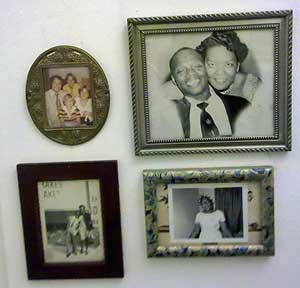
Some buyers at auction sell them to other people, while some – like the African American woman who won the wedding-photos lot – keep them. Sellers on eBay listed plenty of them for sale, including this set of African American jazz photos that sold for $1,600. Everyday and vintage photos of black people get offered and sold (sometimes), too.
My former colleague thought the idea was so amusing that he jokingly asked if I wanted to buy his license photo. I declined, noting that most license photos are so bad that he should pay me to take it off his hands. Another Facebooker thought his request itself was cute.
I used an auction-house sepia photo for the logo on my blog because it spoke to me. She’s a beautiful woman with a book in her hand – not the commonly seen mainstream image of black women from more than a half-century ago. I have one family’s photo album that I couldn’t resist because of the stories the photos told about them and their neighborhood. Turning the pages was like reading a history book without words, each photo bringing me closer to strangers who could’ve been my own family.
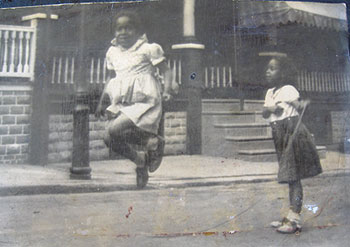
I look at these photos with a discerning eye – whether they’re mine or somebody else’s – because they tell me a lot about how these people lived, especially black people since so much of what society showed of us was negative. With a little Kodak camera, we could present ourselves as we actually were:
We went to the beach, and played in the water or stretched out on the sand. We went to Atlantic City and we looked good doing it. We bought houses and placed Adirondack chairs in the yard. Our beautiful girls played double dutch (or jump rope, as we called it in the South). We bought cars and had accidents in them, and we got married in style.
I thought about my colleague’s puzzlement last week when some friends and I had lunch at Red Rooster Harlem, the restaurant of famed chef Marcus Samuelsson. When I walked into the bathroom, I was faced with a wall of old black and white photos. What a treat.
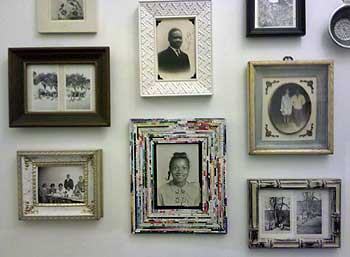
I suspect that they were all photos of strangers, but they made an impressive display – much better than what you often see in restaurant washrooms. They reminded me of the ones I find on the auction tables, and I wouldn’t be surprised if they came from a similar place.
These arrangements were a good example of how to use old photos as decoration. Vintage sepia and black and white photos of family members (or strangers) make a bold statement arranged on a wall. More importantly, it’s a great way to bring them out of hiding in those overstuffed photo albums that we never open.
I don’t have any photo decorations. My first love is fine art, so my walls are filled with paintings. Here are some tips, though, on using vintage photos on your walls:
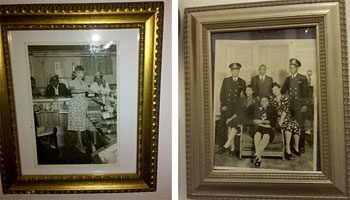
1. There’s no right and wrong way to use the photos. It’s only your way. Choose photos that speak to you.
2. Sketch out your arrangement on a piece of paper. Choose a mix of photo sizes. You want order in your scheme, but you also want to make it interesting with a little disorder (defined in any way you choose). Try to keep the grouping small and contained.
3. Vary the shape of the grouping. Arrangements don’t have to be square or rectangular. Look for shapes around your house and in nature. Groupings can be two photos or they can be five.
4. Use a large photo by itself or as the focus of a grouping of smaller ones. If you like big, go big, but not too big for a grouping. You don’t want to overwhelm.
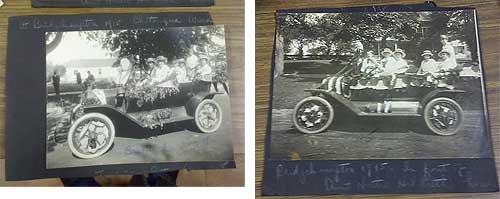
5. Consider themes: all children (mixed group or by gender), men and women (mixed or by gender), family holiday gatherings, soldiers and the military, pets, etc.
6. Consider photos other than ones with people in them. Exterior of homes, inside of homes, buildings, landscapes. I have some old slides of a woman who photographed the building of an addition to her home.
7. Hang photos away from a window. The light will fade them. That’s especially true of paintings. Never hang them near an open window with too much light.
8. Vintage frames are important, too. Consider them when choosing photos. The photo in my blog logo came in its original frame.
9. Save your money and don’t re-frame flea market or auction photos – unless the frames are falling apart. If you need to, buy replacement frames at auction. Most of the old photos come in their original frames, which are usually quite lovely (except for those cheap dime-store gold-tone frames that most families could only afford).
10. If you need help in choosing or hanging, ask a friend with a good eye.

